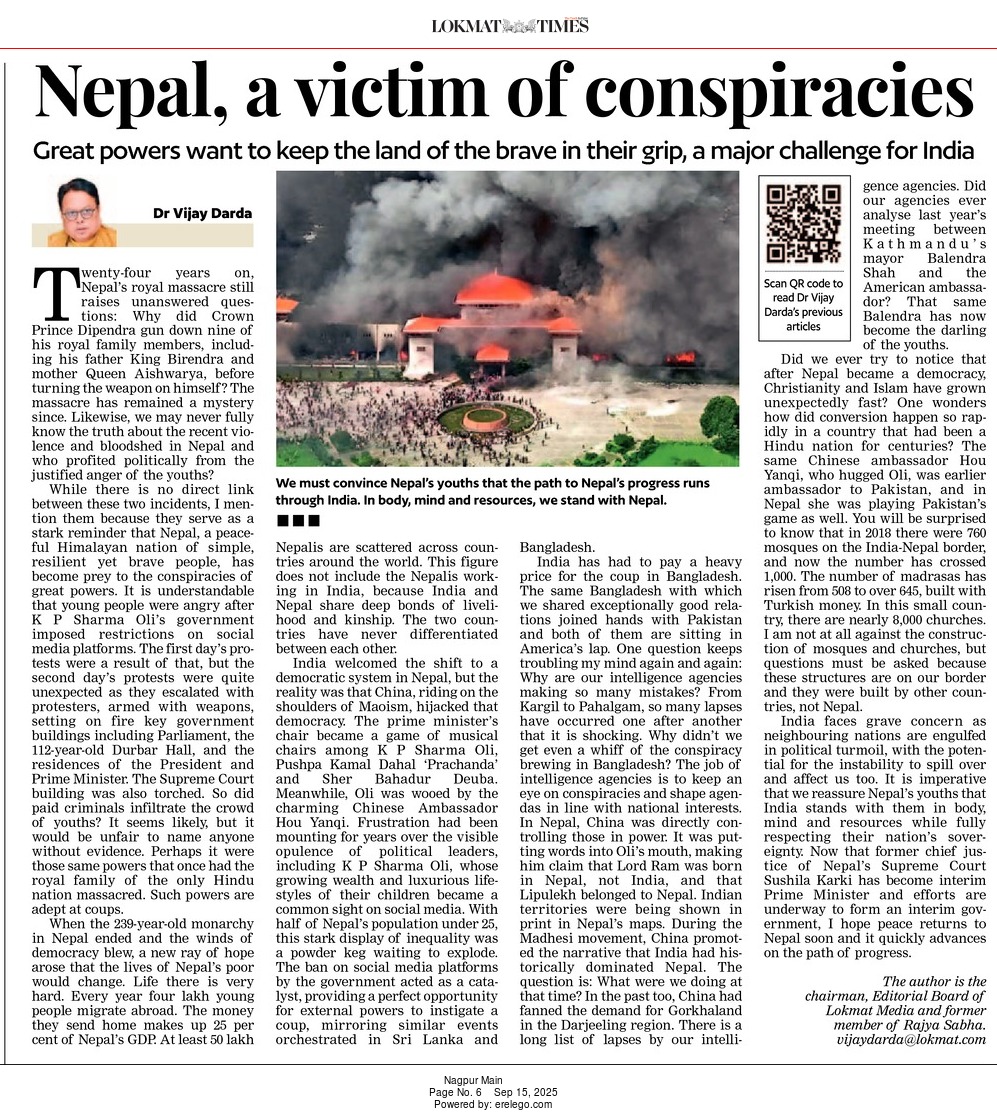Nepal, a victim of conspiracies
 By Vijay Darda | 15-09-2025
By Vijay Darda | 15-09-2025
Great powers want to keep the land of the brave in their grip, a major challenge for India
Twenty-four years on, Nepal’s royal massacre still raises unanswered questions: Why did Crown Prince Dipendra gun down nine of his royal family members, including his father King Birendra and mother Queen Aishwarya, before turning the weapon on himself? The massacre has remained a mystery since. Likewise, we may never fully know the truth about the recent violence and bloodshed in Nepal and who profited politically from the justified anger of the youths?
While there is no direct link between these two incidents, I mention them because they serve as a stark reminder that Nepal, a peaceful Himalayan nation of simple, resilient yet brave people, has become prey to the conspiracies of great powers. It is understandable that young people were angry after K P Sharma Oli’s government imposed restrictions on social media platforms. The first day’s protests were a result of that, but the second day’s protests were quite unexpected as they escalated with protesters, armed with weapons, setting on fire key government buildings including Parliament, the 112-year-old Durbar Hall, and the residences of the President and Prime Minister. The Supreme Court building was also torched. So did paid criminals infiltrate the crowd of youths? It seems likely, but it would be unfair to name anyone without evidence. Perhaps it were those same powers that once had the royal family of the only Hindu nation massacred. Such powers are adept at coups.
When the 239-year-old monarchy in Nepal ended and the winds of democracy blew, a new ray of hope arose that the lives of Nepal’s poor would change. Life there is very hard. Every year four lakh young people migrate abroad. The money they send home makes up 25 per cent of Nepal’s GDP. At least 50 lakh Nepalis are scattered across countries around the world. This figure does not include the Nepalis working in India, because India and Nepal share deep bonds of livelihood and kinship. The two countries have never differentiated between each other.
India welcomed the shift to a democratic system in Nepal, but the reality was that China, riding on the shoulders of Maoism, hijacked that democracy. The prime minister’s chair became a game of musical chairs among K P Sharma Oli, Pushpa Kamal Dahal ‘Prachanda’ and Sher Bahadur Deuba. Meanwhile, Oli was wooed by the charming Chinese Ambassador Hou Yanqi. Frustration had been mounting for years over the visible opulence of political leaders, including K P Sharma Oli, whose growing wealth and luxurious lifestyles of their children became a common sight on social media. With half of Nepal’s population under 25, this stark display of inequality was a powder keg waiting to explode. The ban on social media platforms by the government acted as a catalyst, providing a perfect opportunity for external powers to instigate a coup, mirroring similar events orchestrated in Sri Lanka and Bangladesh.
India has had to pay a heavy price for the coup in Bangladesh. The same Bangladesh with which we shared exceptionally good relations joined hands with Pakistan and both of them are sitting in America’s lap. One question keeps troubling my mind again and again: Why are our intelligence agencies making so many mistakes? From Kargil to Pahalgam, so many lapses have occurred one after another that it is shocking. Why didn’t we get even a whiff of the conspiracy brewing in Bangladesh? The job of intelligence agencies is to keep an eye on conspiracies and shape agendas in line with national interests. In Nepal, China was directly controlling those in power. It was putting words into Oli’s mouth, making him claim that Lord Ram was born in Nepal, not India, and that Lipulekh belonged to Nepal. Indian territories were being shown in print in Nepal’s maps. During the Madhesi movement, China promoted the narrative that India had historically dominated Nepal. The question is: What were we doing at that time? In the past too, China had fanned the demand for Gorkhaland in the Darjeeling region. There is a long list of lapses by our intelligence agencies. Did our agencies ever analyse last year’s meeting between Kathmandu’s mayor Balendra Shah and the American ambassador? That same Balendra has now become the darling of the youths.
Did we ever try to notice that after Nepal became a democracy, Christianity and Islam have grown unexpectedly fast? One wonders how did conversion happen so rapidly in a country that had been a Hindu nation for centuries? The same Chinese ambassador Hou Yanqi, who hugged Oli, was earlier ambassador to Pakistan, and in Nepal she was playing Pakistan’s game as well. You will be surprised to know that in 2018 there were 760 mosques on the India-Nepal border, and now the number has crossed 1,000. The number of madrasas has risen from 508 to over 645, built with Turkish money. In this small country, there are nearly 8,000 churches. I am not at all against the construction of mosques and churches, but questions must be asked because these structures are on our border and they were built by other countries, not Nepal.
India faces grave concern as neighbouring nations are engulfed in political turmoil, with the potential for the instability to spill over and affect us too. It is imperative that we reassure Nepal’s youths that India stands with them in body, mind and resources while fully respecting their nation’s sovereignty. Now that former chief justice of Nepal’s Supreme Court Sushila Karki has become interim Prime Minister and efforts are underway to form an interim government, I hope peace returns to Nepal soon and it quickly advances on the path of progress.
